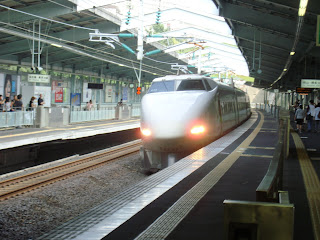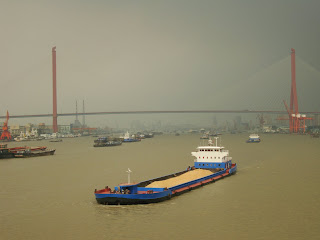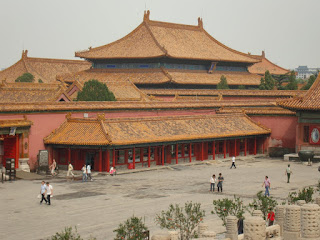







Osaka
We'd booked for three nights in a Ryoken in Kyoto, but given the speed and ease of the rail system, and the fact we had to change at Osaka anyway, we decided to have a look around. Japanese train stations tend to have lots of lockers spread over their underground mazes. Unfortunately ones big enough for our enormous packs are thinner on the ground, and tend to be in use. So we dumped our packs with a bemused gentleman at a manned left luggage (Japan has a system of baggage forwarding, and people don't seem to travel with our quantity of stuff).
Turned around, and amongst the skyscrapers of Osaka business district, we stumbled into a mall (again, Japanese cities seem to be build on top of a warren of connecting malls), and joined the back of a queue at a noddle joint. Sat down at the counter, we were instructed in, by way of mime, the finer points of noddle slurping. Osaka's big draw is its night life, so at lunch time on a rainy Friday, the next best things was the Umeda Sky Building – a pair of skyscrapers joined at the top by a circular crown, serving as an observation platform. The way up is fun (a glass elevator to just below the level of the crown, followed by an enclosed escalator across the void) and the view – a metropolis spread out below you – is never tiring.
Kyoto
Kyoto is Japan's cultural heart. It boasts no fewer than 17 UNESCO World Heritage sites, and hundreds of other shrines and temples. We started of course in the Train station. This is supposedly a modern architectural masterpiece, unfortunately we missed it the first time through, having been turned around marking our way from the Shinkansen platforms, and turning a 5 minute walk to our ryoken, into a half-hour slog.
It turns out the JR station is fairly impressive, with a huge glass roof high above the concourse. Banks of escalators at either end, rising 13 floors to the roof level, where a walkway over the concourse connects them. Dining in a train station is not taboo in Japan, and up on floors 12 and 13 all the restaurants have fine views over the cityscape. I secured myself some tofu dishes by saying “tofu” a lot to the waitress.
For our first day of sightseeing we took a self guided walking tour around Southern Higashiyama. Unfortunately the world and his mother were taking the same route (bloodly lonely Planet). Temple number one was Kiyomizu-Dera. This is a 17th century reconstruction of a temple that originally dates from the 8th century. Being perhaps Kyoto's most famous site, it was busy, but the grounds are fairly extensive, so the crowds were not overwhelming. Interestingly the were lots of young women (usually in pairs), dressed in Kimonos, undertaking a spot of sightseeing. I can only assume that in the same way that the Scots wear kilts to go on the piss, Japanese woman like to wear Kimonos while visiting historical sites.
Several pretty streets selling tourist knick-knacks later, and after passing a couple of Geishas (I assume they were real Geishas, and not the scrag ends of a Japanese hen party), we arrived at temple number two: Kodai-Ji. This is again a beautiful place, set amongst extensive formal gardens. Unfortunately temple fatigue comes all too quickly after three months of travel, and one temple begins to look like any other. Our final temple was Chion-In, headquarters of the Jodo school of Buddhism. We arrived shortly before kicking out time, and Kirsten could barely summon the energy to take more than a few dozen photos. We escaped to the downtown for some much needed coffee.
Day two started with the anticlimax of Higashi Hongan-Ji. This temple was just across the road from our Ryoken. Unfortunately, until 2011, it is encased in a massive metal hanger, while the cracking timbers are repaired. You can still go inside, and on display is the rope used to hoist the largest beams to the ceiling. Unremarkable enough, except this rope is made from human hair donated by faithful women. Yuk.
Kyoto isn't all temples. Next on our list was Nijo-Jo castle. Built in 1603 as the residence of the Shogun, it's an attractive palace and gardens, with inner and outer walls and moats, together with special squeaky floor boards in case a ninja came calling.
Faced with a full afternoon of sightseeing ahead of us, we headed to the mall, where I bought a tee-shirt that said “stupid foreigner” in Japanese, and Kirsten bought some shoes.
The guide books say spend a week in Kyoto (with a day trip to Nara). This may be true if you hadn't spend three months seeing every church and temple from the Balkans to Beijing.




















































